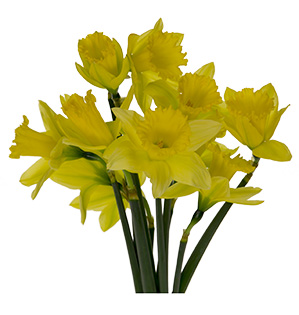Daffodil

Common Names: Daffodil, Jonquil, Narcissus
Botanical names: Narcissus, (nar-SIS-us)
Availability: November through April
Vase life: 3 to 6 days
Storage temperatures: 36 - 38 degrees Fahrenheit
Ethylene Sensitive: No
Description: Trumpet-shaped corona with six surrounding petals in a star shape at the end of a long hollow stem 8 to 22 inches long.
Color: Yellow and white, various shades. Bi-colors of yellow or white petals with orange, apricot and pink coronas.
Botanical facts: Narcissus was the beautiful but arrogant youth of Greek mythology who fell in love with his own reflection and was turned into a plant.
Design notes: Daffodils are frequently displayed alone in a vase, or mixed with other flowers in spring arrangements. These beautiful, unique blossoms add excellent accent to simple design styles.
Purchasing hints: Purchase in the "pencil" or "goose-neck" stage, when the blossoms are still in tight bud but showing some color. Foliage should be green without out any yellowing.
Conditioning: Remove all foliage that will be below the water line. Cut stem ends with a sharp knife. Hydrate in a solution of warm water and commercial floral food for two hours before storage or usage. NOTE: Narcissus must be conditioned alone. Freshly cut narcissus secrete a sap that will shorten the vase life of other flowers, especially tulips. The sap will stop flowing about 6 hours after cutting, they can then be added to other flowers in mixed arrangements. After conditioning, Narcissus should not be re-cut when arranging with other flowers.
Additional notes: The Romans first cultivated the flower, and it remains one of the most popular and well-known cut flowers today; with over 25,000 registered varieties of Narcissi. Prince Charles is paid one Narcissus annually as rent for the unattended lands of Scilly. Feng Shui adherents believe Narcissi bring good luck for twelve months if forced to bloom at New Year.

